I can’t remember a more recent film trilogy that was met with such a mixture of excitement and scrutiny from hardcore fans as much as Peter Jackson’s newest adaptation of The Hobbit. Last year’s An Unexpected Journey was divided amongst not only critics and fans but the most admirable of “Ringers” who follow J.R.R. Tolkien’s texts as religion. After viewing The Desolation of Smaug last night I noticed that this trend will not only continue but build towards another stunning entry in the series that will once again cause uproars among the most dedicated of Lord of the Rings fans. What people desperately need to realize is that The Desolation of Smaug is not the second part in a film trilogy based on J.R.R. Tolkien’s “The Hobbit”, it’s the second part in a a series based off of that novel as well as The Appendices of The Lord of the Rings and entirely new material. The Hobbit, for as wonderfully earnest and gorgeous as it is, is little more than a whimsical children’s tale that opens up the imagination and plays against the light-heated wonderment of visiting a new world. It’s a stark contrast to the dark thematic elements of Tolkien’s more famous follow-up The Lord of the Rings, and those changes are drastically evident while reading both novels back to back. Since Peter Jackson brought the film versions to life in the opposite order in which Tolkien brought us the text he is now in a predicament in which a “faithful adaptation” is no longer an option. You can’t have an entire trilogy based around a light-hearted trek through the forest and not mention the growing evil of The Lord of the Rings, the violent hold that the one ring takes on its bearers and the events of a trilogy that goes on to become the largest event in the history of Middle-Earth. Enter his trusted writing team of Philippa Boyens and Fran Walsh to help give us a more appropriate vision for the big screen. This is the same brilliant (Oscar-Winning) tandem that helped adapt The Lord of the Rings into a record-breaking film series, a trilogy that many said was “unfilmmable”. What they did with The Hobbit was adapt it in a way that many of the famous set-pieces still exist (The barrel chase, the Mirkwood spiders, Smaug the Terrible) but exist in a way that’s not an exact mirroring of the text but a set-up to the events in the next trilogy. You simply can’t have Bilbo throwing stones at the venomous spiders of Mirkwood and hurling verbal insults left and right when we’re already seen the utter terror of the spider Shelob in The Return of the King. That entire aspect must be thrown out of your mind because quite frankly it just wouldn’t work in the slightest on screen, and the movie would morph into more of a cartoon than an epic journey. They’ve not only managed to piece these memorable moments together in a brand new way but at the same time lay down the groundwork for a second entry in the series, The Desolation of Smaug, which was as visually masterful as it was pulse-poundingly exciting.
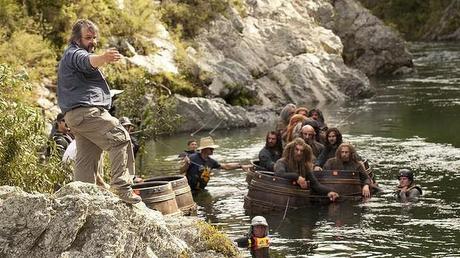
Peter Jackson is back up to his mesmerizing ways in Middle-Earth
When we last saw our heroes in An Unexpected Journey they had just outran the orc pack that had been hunting them down on their trip to The Lonely Mountain. The Desolation of Smaug however opens up with a sequence in Bree between Gandalf and Thorin before the events of the first movie, one that exists as a means for exposition and background information for the audience. We see the familiar town from The Fellowship of the Ring looking as if they never tore down the set and just went back in time to film the sequence for the newest trilogy. Even The Prancing Pony looks as if it were never touched and the feelings of nostalgia created in just a few minutes are enough to suck any fan of The Lord of the Rings right into this new adventure. From there we’re treated to what can sort of be described as a “highlight reel” of set-pieces from the novel mixed with entirely new moments and characters created for the trilogy. They’re hurried through Beorn’s house into the sequence in which they’re lost in Mirkwood Forest, which lasts for only a few moments, as well as the battle against those horrifying spiders that is resolved sooner rather than later. They’re then quickly rushed through Thranduil’s Palace, into the elven prisons and right out into the famous “barrel escape” moment from the text before meeting Bard and sent into the iconic showdown against Smaug. For those who felt An Unexpected Journey took too long to set-up and carried too slowly out of the gate will be overjoyed to find that the pacing of this movie is very swift and almost rushed in areas. The fast-pace is perfect for the new additions to the movie as you never quite get a change to catch your breath until you’re plunged into the final act between Bilbo and Smaug. Now one shouldn’t mistake this with a hurried feeling that makes it seem as if you’re missing key character descriptions or information on the settings, because you aren’t. The screenplay here does a wonderful job of introducing the audience to locations and heroes that weren’t seen in the first movie but have enough of a description that you never once ask “wait, who is this again?”. You definitely won’t be looking at your watch this time around and wondering how much longer there is but you might be staring at it wondering where some of those scenes were swept off to. It’s not that the movie pushes too fast through certain areas, because they merely serve their purpose to the story, it’s just that the moments of pause between the chaos could’ve been better used to flesh out other characters.
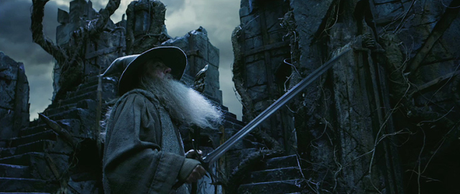
Gandalf has a solo adventure this time around
Speaking of characters, the titular hero of Bilbo Baggins gets a much more focal arc in this entry while dealing with a lingering mental madness that’s hinted at across multiple heroes in the story. Martin Freeman gets to flex his dramatic chops here as Bilbo goes from the “everyday man” to a much more open and adventurous member of Thorin’s company. He takes on a leadership role and isn’t only outspoken and confident but winds up actually nudging people into danger rather than the other way around like in An Unexpected Journey. It’s a beautiful arc that’s the next step of becoming the Bilbo Baggins we all know and love from The Lord of the Rings and it’s easily one of the best written aspects of the story. However, at the heart of this entire Tolkien series lies the one ring. Yes, one ring to rule them all, one ring to find them, one ring to bring them all and in the darkness bind them. We’ve seen how the ring has corrupted Gollum and drove Frodo to the brink of madness but what of Bilbo? In the novel this mental strong-hold was vaguely hinted at since Tolkien was simply telling a children’s tale and had not yet fully realized the great importance of the famed jewel. Here is where Peter Jackson’s liberties shine as we start to see moments of Bilbo’s attachment to the ring go stronger and, at times, even more frightening. We’re treated to scenes of him unable to sleep because of his infatuation with the ring, we see him constantly stroking and grabbing at it through the entire journey and we even see him kill for it. This key development does so much more to the overlying importance of the series and the much-needed presence of darkness in Middle-Earth. It’s the tone here that’s much darker and more twisted that is the key area of the film’s vast improvements. I can’t say enough about how the atmosphere of the movie and the raised stakes alters the reaction to the movie and the emotions that are brought forth. When talking about the film’s strengths and ties to The Lord of the Rings than the shift in tone is one of the key areas. This isn’t the only change Jackson makes in connection to the ring (you’ll see this a lot) as he also adds a ferociously heavy dose of Sauron, or who he is now which is “The Necromancer”, the dark spirit of the villain from the Rings trilogy. We all know that in the novel Gandalf leaves the company throughout half of the movie and comes back dozens of chapters later but in the film we as an audience must know where he was during that time. That set-up now became the perfect way to introduce Sauron to the story yet again (after he was hinted at briefly in An Unexpected Journey) and it give us the pleasure of seeing Gandalf’s realization of the Enemy’s return. This works wonders for not just this second film but for the entire series as a whole, and in my opinion it’s one of the best things about the new additions in The Desolation of Smaug.
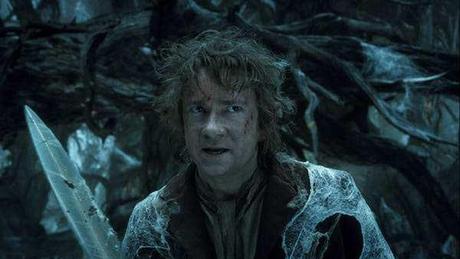
Martin Freeman once again shines as Bilbo Baggins
Gandalf’s research of The Necromancer and the Nazgûl are not the only key additions to the story as the presence of the elves is greatly amplified with the return of Legolas from The Lord of the Rings as well as the addition of Tauriel, played by Evangeline Lilly. These two characters add a much needed spice to the bearded and ironclad dwarves of the series since it was the melting pot of races in The Lord of the Rings that created such wonderful character dynamics. Tauriel is one of the best parts of The Desolation of Smaug for not only her much needed female presence but for her character arc and conflicted identity. We’re treated to a very black and white image of Middle-Earth in this movie where it’s clear that the dwarves and elves do not mix, so to see an elf who simply believes in the nature of good vs. evil and can see through most racial impurities is refreshing. Her sense of honor is one that is tied to her belief in doing what’s right rather than doing what’s expected of her, and I think that has a lot of social commentary on not just the racism of our society but the gender roles as well. As Evangeline Lilly said in an interview during the press tour, it is simply unacceptable to have a 9 hour film experience in today’s cinematic landscape and not feature a single female character. Her passion for this was seen on screen with her performance as she’s able to dominate the physical work with breathtaking fight sequences as well as the ability to give us a glimpse inside her mind. As for our other elf Legolas, here he is a bit more reluctant to break the rules and that shouldn’t really come as a surprise since his father Thranduil plays alongside him for a majority of his scenes. With Orlando Bloom back in the role that made him a household name he is able to sleep seamlessly into the mysterious and mild-voiced character that stole so many scenes from the original trilogy, and he manages to steal just as many here. The amount of unbelievable fight choreography that exists in Legolas’s battle sequences are too numerous to count as he’s a whirlwind of orc ass-kicking with a layer of decapitations, flying spin moves and gravity-bending agility. His role in the movie has been greatly increased from a mere cameo as he’s heavily involved in not only the majority of the Mirkwood sequences but some of the Lake-Town ones as well.

Tauriel and Legolas are two of the best additions to the story
One does not simply watch a Peter Jackson Tolkien movie without mentioning the visuals and once again this is no different from his previous treks through Middle-Earth. We’re treated to sweeping landscapes, staggering mountain passes and too many vertigo moments to mention in one small sentence. The movie looks absolutely stunning and the set-pieces they put together like the city of Lake-Town, which was the highlight of the art direction in my opinion, are majestically detailed and carved to perfection. The forest of Mirkwood is budding with contrasting colors which leave you as dizzy as the characters and Smaug’s lair (which we’ll get to in a minute) is an overflowing mountain of gold, gemstones and high-reaching, cavernous walls. However the complaints I had with the movie once again stem with the physical look like they did with the aesthetics in An Unexpected Journey. The CGI, while very good in places, is simply used too much. There’s no other way to explain the over-reliance on special effects in this movie and it really does take away from certain areas. I understand that special effects MUST be used for a movie of this magnitude, especially since they’re building an entirely new world from scratch but how much is too much? Why have they gone from using actual stunt-men in orc make-up during the fight sequences to using completely CGI rendered designs? Take the climatic battle in The Fellowship of the Ring at Amon Hen for example. They used 100% real stunt-men in uruk-hai armor and the result is that when one of them pushes and grabs our characters they fall and react as if someone is there, because someone actually is there. There’s tension and fear for these characters that accompany that overwhelming pit in your stomach because they might actually die. There is very little of that feeling in The Desolation of Smaug save for a brief encounter towards the end of the movie with the titular dragon. For all of the bountiful and masterful action in this movie, and trust me there’s plenty of it, we’re treated to too many moments that break the laws of gravity and seem to come straight out of a video-game. Yes, Legolas took down a gigantic Oliphant in The Return of the King but here he takes out almost a hundred orcs all at once as if they were nothing more than an inconvenience… and that’s what’s lacking a little bit. The danger. The tension. A lot of that is simply limited when you have your characters make impossible jumps in caverns, impossible throws in fight scenes and impossible precision when firing arrows. I can absolutely go with it because of the source material of the story but it gets to the point that when you see them do the impossible so many times you just expect them to get out safely since, well, they can literally do anything. Again, this is a fantasy-adventure and I completely understand that but when watched back to back with the world they created in Rings it’s hard to look at them as the same co-existing universe, at least from the physical aspect. However while I did feel they went too far in certain places I also felt that what they accomplished in those battles was visually breath-taking, and littered with some of the best choreography I’ve seen from a fight sequence at the movies in years. Make no mistake, these were wonderfully engaging sequences that had a GIGANTIC SMILE on my face throughout the entire time.
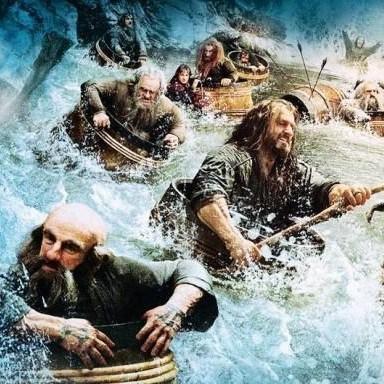
The Barrel Escape is the most thrilling and exciting moment in the movie
Throughout this review I’m sure you’ve been wondering “Where is the mention of Smaug? You know, the DRAGON IN THE GODDAMN TITLE?”. Well, truth be told I’ve been holding off on this because I really, truly believe that the entire final confrontation with Smaug should be seen with a blindness to the event and with a completely clean slate. I can, however, speak to that sequence as the crown jewel of the movie and that’s exactly what it was. There’s a reason Peter Jackson showed very little if any of the dragon before the movie’s release and that’s because when you first see it you can’t believe your eyes. We’ve seen plenty of CGI creations in the last decade and a half of filmmaking and Smaug immediately jumps right up there with the greats on that list. His design aesthetic and textural skin-tones are so real to the point that there are times you truly feel like Martin Freeman is acting opposite of an actual dragon. The voice work (and motion capture) of Benedict Cumberbatch is absolutely brilliant here as his words audibly echoes off the walls of the theater. While the movie is a fast-paced thrill ride that jumps from scene to scene and location to location the showdown with Smaug is a much needed break from the chaos and a glimpse inside a mental chess-match between two quick-witted characters. Smaug is played up to be just as cunning and devious as we remember from the novel and they even managed to throw in more than a handful of lines from the book as he and Bilbo exchange barbs with one another. From the moment the company steps into the halls of Erebor to the very last line of the movie we’re treated to a dazzling spectacle that assaults not only the visual expectations but the small-scale ones as well. This is where a lot of that tension I found missing before is hidden as our rag-tag group of dwarves (with half of them left back in Lake-Town, a great variation from the book) take on Smaug with the skills of what they know rather than common weapons. The entire final half hour or so is as must-see cinema as you can possibly get, and worthy of the price of admission alone.
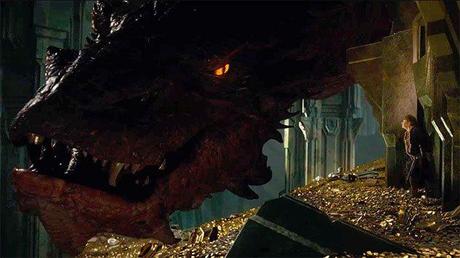
It comes as no surprise that the highlight of the movie is the confrontation with Smaug
The well-rounded and stacked cast is again one of the film’s biggest strengths as Richard Armitage’s Thorin is given a much more devious character arc than before. We know all about the sickness of the mind which invaded over his forefathers and his overwhelming obsession with taking back Erebor is not only deterring him from his friends but clouding his judgment. Luke Evans brings a shadowy, roguish presence to the series that hasn’t been felt since our introduction to Strider back in The Fellowship of the Ring. His fear of the dragon that’s been weighing on him over generations of pain and misfortune is one of the more emotional layers to a film that’s asking for more of it. It’s that shadowy, broken past that we gravitate towards in a character because who better to come through and save the day than the one cast aside and least expected of the heroic deed? Aidan Turner’s Kili gets much more to do in this film whereas in the last one he was simply there to be the “sexy dwarf” (come on, you know it to be true!). He has an unexpected romance with Tauriel that at first starts as flirtation and simply needs to be fully realized in the next movie for me to judge it as a whole, because as of right now it simply exists to form a bond between the two races. The rest of the supporting cast fill in admirably with Lee Pace being the next in line for a larger role as the Elven King Thranduil. He plays his mannerisms up too much for my taste in certain scenes but ultimately brings forth a character obsessed with not only his own ego but the selfish desire to claim as much for himself as he possibly can. He brings the movie a character we come to almost hate in certain ways and despise greatly at times, and I think that presence was much needed when our villains for a lot of the movie up until that point are nameless orcs and Azog’s right-hand man.
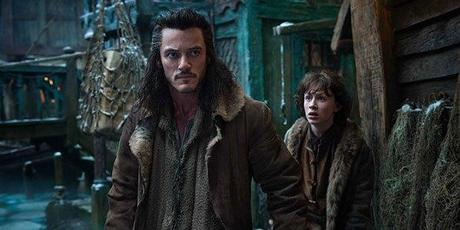
Bard the Bowman brings a much needed human presence to the movie
Much like An Unexpected Journey was The Desolation of Smaug is a movie that’s not without its flaws but those flaws play second-fiddle to the core narrative and an unwavering commitment to spectacle. The familiarities of Middle-Earth that we love and remember are very much present such as the majestic aerial landscapes and beautifully captivating score by Howard Shore. The action is at times over the top but still more in line with the tone of the book, and I think that’s where sometimes the balancing act goes a bit too far. It’s almost impossible to blend the whimsical fairy-tale nature of the text and the grounded realism aspect of The Lord of the Rings film trilogy. As soon as fans realize that The Hobbit is not a re-telling of the classic literature but an adaptation of the source material morphed into a means to bridge the gap to one of the most beloved film trilogies of all-time than the sooner they’ll get attached. I, for one, have been on board since the very beginning and have fully accepted this creatively ambitious structure of story-telling to the point that I am dying to see what they come up with in the final installment. You must separate the book from the film and understand that Peter Jackson is essentially telling Tolkien’s work in the reverse order of his writing, and long after the author openly acknowledge wanting to go back to “The Hobbit” and add aspects from Rings. What the trio of Jackson, Boyens and Walsh did here was create an overly ambitious and wonderfully exciting film that assaults the senses, makes fans of the text happy and still sets the stage for a tremendous final act that will sure to be the very best of this Hobbit Trilogy. I can’t recommend The Hobbit: The Desolation of Smaug highly enough, and for those 2 and a half hours you’ll be transported from a dark movie theater to an entirely different world of imagination and wonderment. 9/10
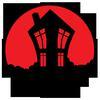

posted on 26 December at 17:11
While I agree with this review for the most part, I most certainly do not agree with the reason why he gave this movie a 9/10 rating. His criticism is irrelevant to me, because he contradicts himself. This critic says that the CGI was used too much and it "take[s] away from certain areas" because there wasn't a sense of danger in the action sequences, yet he also said that they were "visually breath-taking" and "wonderfully engaging sequences." Interesting. There is also another contradiction in this review, where the critic states that the visuals were "no different from his [Jackson's] previous treks through Middle-Earth", yet later in the same paragraph, he says that the previous Lord of the Rings movies didn't overdo it on the visual effects because they used "100% real stunt-men in uruk-hai armor and the result is that when one of them pushes and grabs our characters[,] they fall and react as if someone is there, because someone is actually there." Who cares? It sounds like he's just looking for lame excuses to not give this movie a 10 rating. Either that or he simply doesn't know what he's talking about. He does realize that Elves are able to do what would be considered "impossible" for humans, right? He also realizes that Legolas is a complete badass, right? CGI is kind of necessary for these scenes, especially in the barrel scene. Using real stunt men would not have made these scenes any less exciting or suspenseful, in my opinion of course. In the book, the part of the story where the dwarves escaped in barrels was hardly exciting at all, because the barrels were enclosed and there were no orcs or elves chasing them. So adding an action sequence alone was a good idea because it made that part of the story more exciting, regardless if the scene was CGI or not. Plus, where is the suspense or sense of danger when you already know what's going to happen? I assume he read the book. I have no right to criticize this movie because I don't know the first thing about making a movie, let alone an film adaptation of a Tolkien novel. He acts like using stunt men is just as easy as taking a walk in the park. However, using stunt men would have meant more time and money, and the budget for this movie was already ridiculous. I'd like to see this guy try to make an adaptation of a Tolkien novel and see how it turns out.